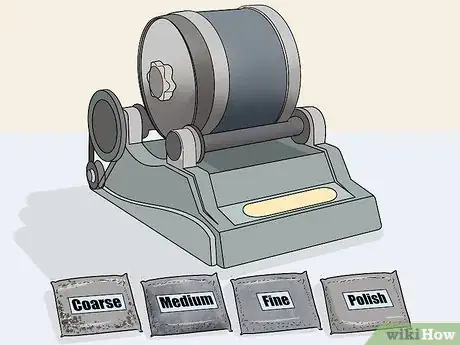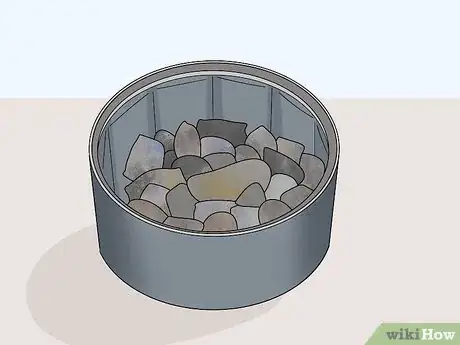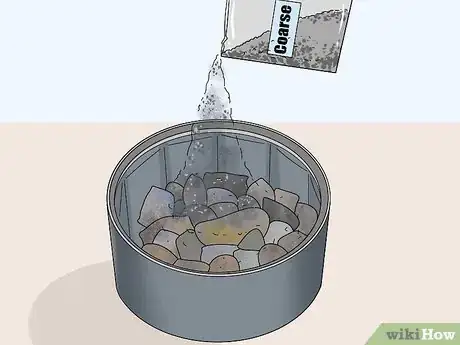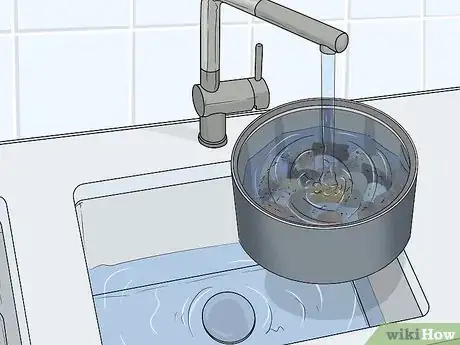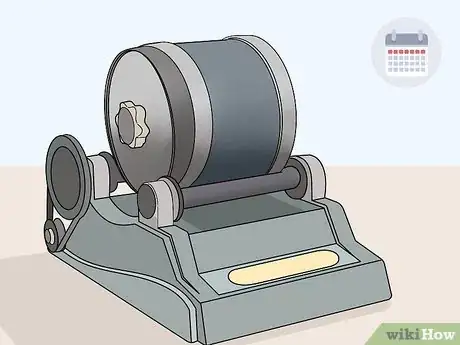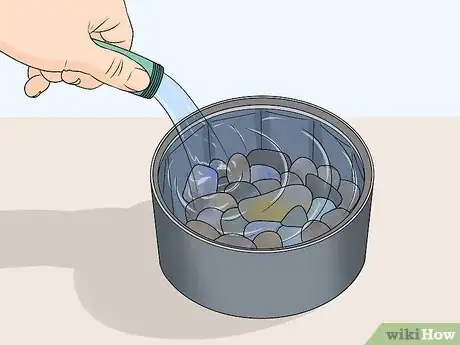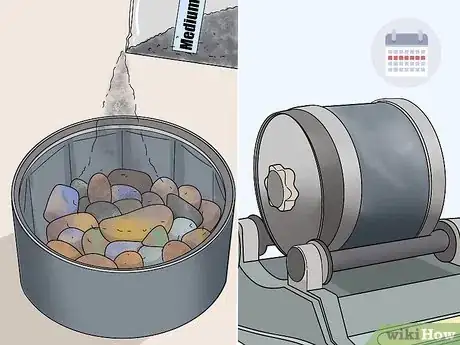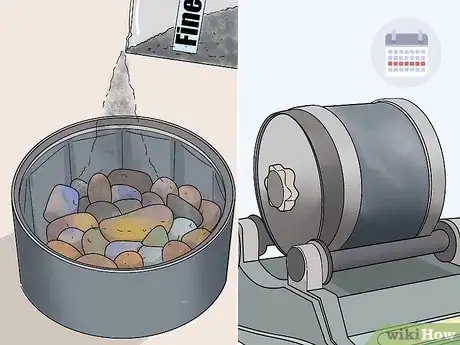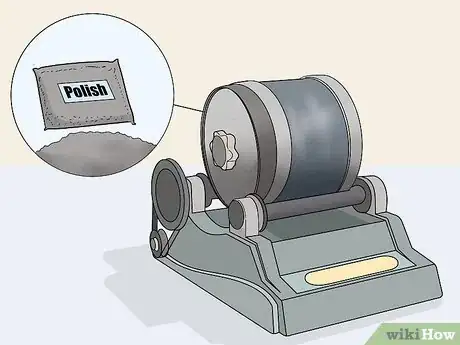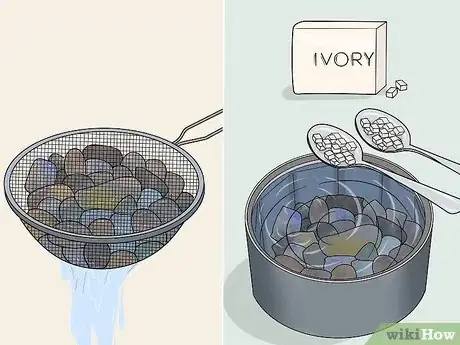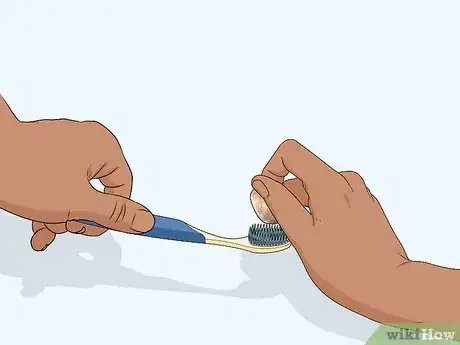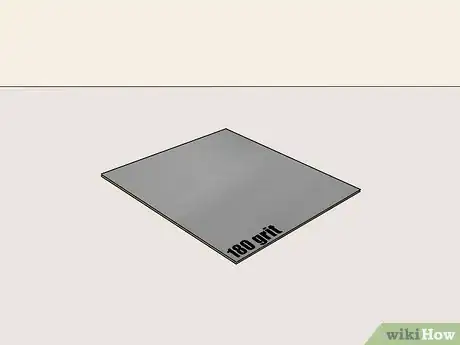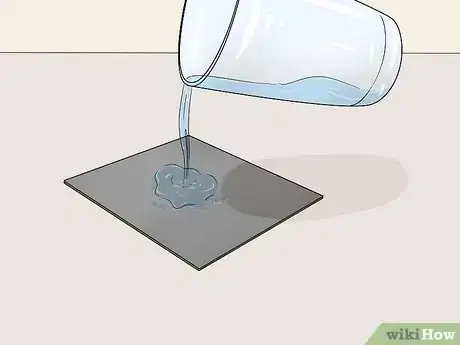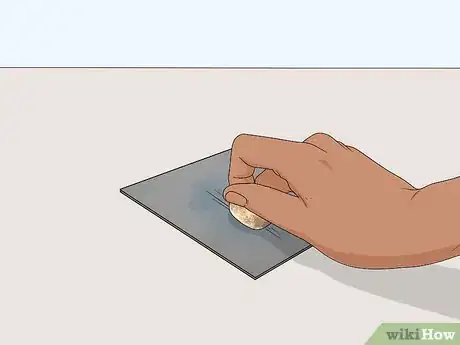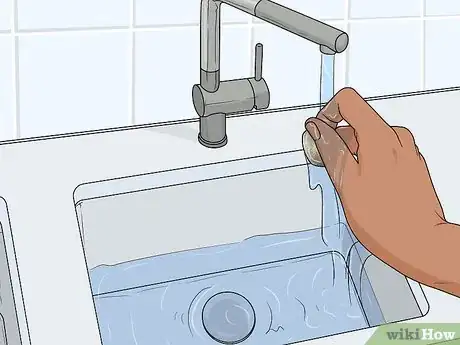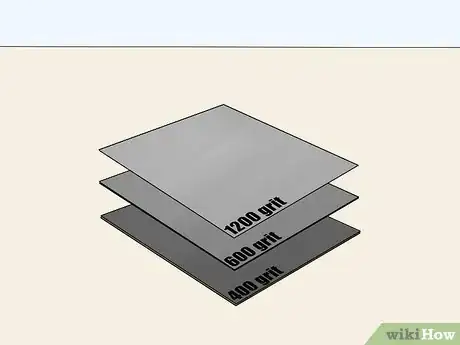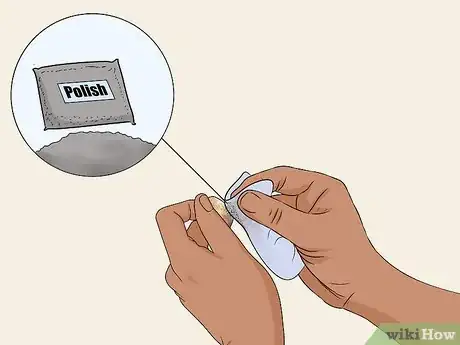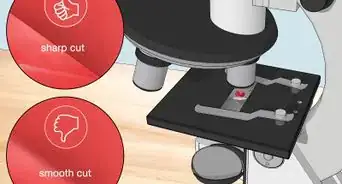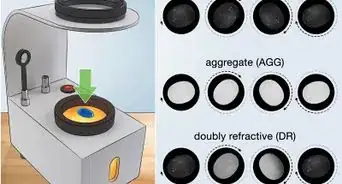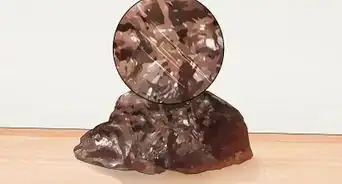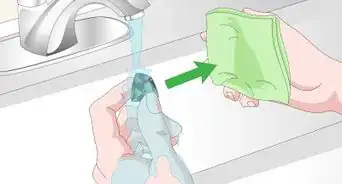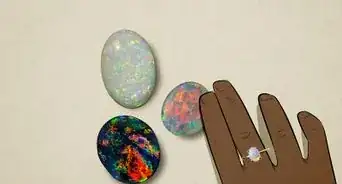This article was co-authored by wikiHow Staff. Our trained team of editors and researchers validate articles for accuracy and comprehensiveness. wikiHow's Content Management Team carefully monitors the work from our editorial staff to ensure that each article is backed by trusted research and meets our high quality standards.
There are 11 references cited in this article, which can be found at the bottom of the page.
This article has been viewed 19,714 times.
Learn more...
Agate is a multicolored gemstone that is popular with collectors because of its vibrant color patterns. The best way to show off these patterns is with a thorough polishing. For the best results, use a rock tumbler. This device puts the stones through several weeks of grinding and polishing to smooth the stone and unlock its colors. If you don’t have a tumbler and don’t want to get one, then you can also polish the stones by hand with only sandpaper and some powdered polish. Either method will show off the brilliant patterns of these stones.
Steps
Loading a Rock Tumbler
-
1Get a hobby-level rock tumbler. There are 3 levels of rock tumblers: toy, hobby, and commercial. A toy tumbler won’t have much effect on the rocks, and you probably don’t need a commercial tumbler unless you’re doing very large loads or plan on selling the rocks. Hobby-level tumblers are fine for most needs. Pick one up for $50-$300, depending on the size and model.[1]
- Tumblers come in sizes ranging from 3 lb (1.4 kg) to over 20 lb (9.1 kg). Unless you have a large rock collection to polish, a smaller one is probably fine.
- You can buy tumblers online or at hobby stores.
- If you’re only polishing a few rocks or don’t plan on doing this again, then use a handheld polishing method. You may also be able to rent or borrow a tumbler for a one-time job.
-
2Fill the tumbler 3/4 of the way with agate. Open up the tumbler and place your agate inside. Fill the tumbler 3/4 to the top with agate. If you don’t have that much agate, then use a filler material to fill the tumbler the rest of the way. Filler material is available for purchase online or at hobby stores.[2]
- You can place other rocks in the tumbler as well, but make sure they match the hardness of agate to avoid damaging them. Agate is a 7 on the hardness scale, so use other rocks that are a 7 like quartz and jasper.
- Different rock tumblers may have different instructions on how much to fill. Always follow the instructions that come with your product. Check inside for a fill line.
Advertisement -
3Pour the coarse-grit carbide inside the tumbler. Tumblers put rocks through 4 stages grinding: coarse, medium, fine, and polish. Start with the coarse carbide to grind down the rough outer layer. Scoop in the instructed amount of carbide.[3]
- The amount of grit to add depends on the size of the tumbler you’re using. Follow the instructions that come with the tumbler for the right measurement.
- Typical amounts are 3 tbsp (45 g) for a 2 lb (0.91 kg) tumbler, 4 tbsp (60 g) for a 3 lb (1.4 kg) tumbler, and 8 tbsp (120 g) for a 6 lb (2.7 kg) tumbler.
- All the stages usually come in starter tumbling kits, or you can buy different stages individually.
-
4Add just enough water to cover the rocks. Hold the tumbler under the faucet and fill it with water. Stop when the water is just even with the rocks. Some rocks can break the surface slightly. Then close the tumbler cap.[4]
- Never let the rocks get dry throughout this whole process. Tumbling the rocks while they’re dry will crack them.
Smoothing the Rocks in the Tumbler
-
1Run the rock tumbler for 7 days. Place the tumbler on its base and turn it on. The tumbler will start spinning. Leave it undisturbed for 7 days so the carbide grinds away the rough exterior.[5]
- The tumbler makes some noise, so you may want to place it in a secluded area like your garage.
- You can check on the rocks while the tumbler works. Turn it off, open the cap, pick out a rock, and rinse it off to see how the progress is going. Then just put the rock back in and turn the tumbler back on.
- You can also run the tumbler for shorter or longer, depending on what result you want. Grind them longer if they have a lot of built-up grit on the exterior. Keep in mind that grinding them much longer might break up more of the rock than you wanted to, so keep the tumbling around 7 days.
-
2Drain the rocks through a colander outside. After 7 days, take the tumbler outdoors. Empty the tumbler into a colander over grass or dirt. Shake the colander to drain the pasty slurry off the rocks.[6]
- Do not drain the rocks over a sink. This will clog your plumbing.
- Also avoid emptying the tumbler near a storm drain. If a rock bounces out, it could get lost down the drain.
-
3Rinse the rocks and the inside of the tumbler. The slurry makes the rocks all look gray. Don’t worry, they aren’t ruined. Use your hose and spray the rocks to rinse them off. Then spray the inside of the tumbler to remove any leftover grit material.[7]
- Rinsing is especially important because coarse carbide can damage the rocks when you move on to finer grains.
-
4Add the medium-grit carbide and run the tumbler for another 7 days. After washing the rocks thoroughly, put them back into the tumbler. This time, add the medium-grit carbide. Cover the rocks with water, then run the tumbler for 7 more days. When that's finished, remove, drain, and rinse the rocks again.[8]
- Remember that since the rocks grind down with each step, they may not take up the same volume from one step to another. Add filler if you have to so the tumbler is always 3/4 of the way full.
-
5Complete the grinding with fine-grit carbide for 7 days. After running the tumbler with the medium-grit for a week, remove and rinse the rocks and tumbler. Put them back into the tumbler and add the fine-grit carbide and water. Run the tumbler at this stage for another 7 days, then take the rocks out and rinse them.[9]
- For this step, you'll probably need some filler because the rocks will be smaller than before.
-
6Run the rock tumbler once more with polishing grit. The final tumbler stage is with the polishing carbide. Load the tumbler as you did before. Then, scoop in the instructed amount of polishing carbide. Run the tumbler for a final 7 days to finish polishing the agate.[10]
- At this point, you’ll probably need filler. The rocks have been ground down and won’t take up as much space. They may also scratch each other without a bit of a buffer between them.
-
7Remove and rinse the agate after 7 days. The polishing course finishes off the job. Open the tumbler and drain the rocks out like you did before. Rinse each rock thoroughly and dry it with a clean towel. Enjoy your newly-polished stones![11]
- If the rocks still look a little dull after rinsing, then burnish them in the tumbler for 24 hours. Load them in with water and add 2 tbsp of chopped Ivory soap, which is especially mild and won't stain the rocks. Rinse the rocks after 24 hours have passed.
Buffing Agate Manually with Sandpaper
-
1Clean each stone with warm water, dish soap, and a toothbrush. Remove any dirt or debris that’s built-up on the rock’s exterior. Fill a cup with warm water and squeeze in a drop of dish soap. Stir the mixture so it suds up. Then, dip the toothbrush in and scrub each rock thoroughly.[12]
- Agate sometimes has surface crevices that dirt hides in. Pay attention to these areas and try to push the bristles into them for a thorough clean.
-
2Lay 180-grit sandpaper on a flat surface. A flat and stable tabletop is a good surface to work on. Take a piece of sandpaper at least 3 in (7.6 cm) by 3 in (7.6 cm). Place down a towel so you don’t get debris on your table. Then lay the sandpaper flat on top of it.[13]
- Lay down a cutting board for an extra layer of protection for your table.
- You can also use a Dremel tool to polish the rocks. Make sure you attach a polishing bit, because using a coarse bit will grind the rock down too much.
-
3Add a drop of water to the sandpaper. Don’t sand rocks while they’re dry or you’ll scratch them up. Take a cup and pour a drop of water a few times larger than the rock you’re polishing directly onto the sandpaper.[14]
- Don’t worry if a lot of water comes out. Too much water is better than not enough.
-
4Grind the stone on the sandpaper until the surface grit rubs away. Pick any side to start on. Rub back and forth with even pressure to grind off the agate’s rough exterior. Switch to a different side when the previous section smooths out. Work around the whole rock with the same technique.[15]
- Keep the rock wet through the whole sanding process. If the water dries up at any point, add more.
- Don’t worry if the rock doesn’t look smooth or shiny yet. The coarse-grit only works off the rough edges.
-
5Rinse the stone off in between grinding stages. Run the stone under the faucet to remove any debris and sanding material. Don’t forget to rinse the stone after each sanding session so the sanding grits don’t cross-contaminate.[16]
- Don’t worry about drying off the stone. Keep it wet for the sanding process.
-
6Repeat the process with 400, 600, and 1200 grit sandpaper. Work your way up to finer-grit sandpaper to gradually polish the stone. Use the same technique for each grit. Rinse the stone off and grind each side until it smooths out. As you reach finer grits, the stone will shine a bit more.[17]
- Remember to rinse the stone and wet each piece of sandpaper before you start sanding.
-
7Rub the stone with powdered polish. Apply some powdered polish to a rag. Then rub each side of the stone until it shines. Rinse it one last time and dry it with a clean rag.[18]
- You can buy powdered polish at a hardware store or online.
Things You'll Need
Loading a Rock Tumbler
- Agate
- Rock tumbler
- Water
- Filler material
- Coarse, medium, and fine-grit carbide
Smoothing the Rocks in the Tumbler
- Agate
- Rock tumbler
- Water
- Filler material
- Coarse, medium, and fine-grit carbide
- Colander
- Hose
Buffing Agate Manually with Sandpaper
- 180, 400, 600, and 1200-grit sandpaper
- Agate
- Rag
- Powdered polish
- Water
References
- ↑ https://rocktumbler.com/rock-tumbling-instructions.pdf
- ↑ https://youtu.be/ik2DTbTfx8s?t=51
- ↑ https://rocktumbler.com/rock-tumbling-instructions.pdf
- ↑ https://rocktumbler.com/rock-tumbling-instructions.pdf
- ↑ https://rocktumbler.com/rock-tumbling-instructions.pdf
- ↑ https://youtu.be/Vsw5zxU6chA?t=92
- ↑ https://rocktumbler.com/rock-tumbling-instructions.pdf
- ↑ https://youtu.be/Vsw5zxU6chA?t=294
- ↑ https://youtu.be/Vsw5zxU6chA?t=431
- ↑ https://rocktumbler.com/rock-tumbling-instructions.pdf
- ↑ https://rocktumbler.com/rock-tumbling-instructions.pdf
- ↑ https://sciencing.com/polish-rocks-gems-rock-tumbler-8164627.html
- ↑ https://youtu.be/Nd6_wIczcMk?t=82
- ↑ https://youtu.be/Nd6_wIczcMk?t=87
- ↑ https://sciencing.com/polish-rocks-gems-rock-tumbler-8164627.html
- ↑ https://youtu.be/Nd6_wIczcMk?t=117
- ↑ https://youtu.be/Nd6_wIczcMk?t=69
- ↑ https://sciencing.com/do-polish-sliced-agate-8572393.html
